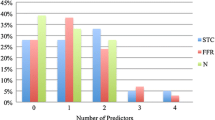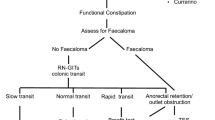Abstract
Purpose
Adult slow-transit constipation (STC) occurs predominantly in females and is associated with low numbers of substance P (SP)-containing nerves in colonic circular muscle.
Aim
To determine if reduced SP nerves is female predominant in paediatric STC.
Methods
Children with STC were identified from records of more than 600 nuclear transit studies (NTS) and intestinal biopsies done for intractable chronic constipation between November 1998 and March 2009. Colonic seromuscular biopsies collected from hepatic and splenic flexures, and sigmoid colon were processed for immunohistochemistry. Nerve fibre density in circular muscle containing SP was measured qualitatively by a pathologist.
Results
Eighty-eight children with chronic constipation had both NTS and intestinal biopsies. Seventy-eight children (52 M; age 2–15.5 years; mean 7.7 years) had STC diagnosed by NTS. SP was reduced in 10/26 girls, but only 11/52 boys.
Conclusion
In this sample, STC was more common in boys than girls. However, in girls with STC, SP deficiency occurred in 40%, when compared with 20% of boys. During puberty, the percentage of girls with reduced SP decreased, whilst the percentage of boys increased. These results suggest that STC is heterogeneous and that there are some gender differences, the implication of which requires further investigation.

Similar content being viewed by others
References
Sutcliffe JR, King SK, Hutson JM, Cook DJ, Southwell BR (2009) Gastrointestinal transit in children with chronic idiopathic constipation. Pediatr Surg Int 25:465–472
Stanton MP, Hutson JM, Simpson D et al (2005) Colonic manometry via appendicostomy shows reduced frequency, amplitude, and length of propagating sequences in children with slow-transit constipation. J Pediatr Surg 40:1138–1145
King SK, Catto-Smith AG, Stanton MP et al (2008) 24-Hour colonic manometry in pediatric slow transit constipation shows significant reductions in antegrade propagation. Am J Gastroenterol 103:2083–2091
Holzer P, Holzer-Petsche U (1997) Tachykinins in the gut. Part I. Expression, release and motor function. Pharmacol Ther 73:173–217
Maggi CA, Catalioto RM, Criscuoli M et al (1997) Tachykinin receptors and intestinal motility. Can J Physiol Pharmacol 75:696–703
Southwell BR, Furness JB (2001) Immunohistochemical demonstration of the NK(1) tachykinin receptor on muscle and epithelia in guinea pig intestine. Gastroenterology 120:1140–1151
Southwell BR, Woodman HL, Murphy R, Royal SJ, Furness JB (1996) Characterisation of substance P-induced endocytosis of NK1 receptors on enteric neurons. Histochem Cell Biol 106:563–571
Harrington AM, Hutson JM, Southwell BR (2005) Immunohistochemical localization of substance P NK1 receptor in guinea pig distal colon. Neurogastroenterol Motil 17:727–737
Lavin ST, Southwell BR, Murphy R, Jenkinson KM, Furness JB (1998) Activation of neurokinin 1 receptors on interstitial cells of Cajal of the guinea-pig small intestine by substance P. Histochem Cell Biol 110:263–271
Vannucchi MG, Corsani L, Faussone-Pellegrini MS (1999) Substance P immunoreactive nerves and interstitial cells of Cajal in the rat and guinea-pig ileum. A histochemical and quantitative study. Neurosci Lett 268:49–52
Porter AJ, Wattchow DA, Hunter A, Costa M (1998) Abnormalities of nerve fibers in the circular muscle of patients with slow transit constipation. Int J Colorectal Dis 13:208–216
King SK, Sutcliffe JR, Ong SY et al (2010) Substance P and vasoactive intestinal peptide are reduced in right transverse colon in pediatric slow-transit constipation. Neurogastroenterol Motil 22:883–892, e234
Southwell BR, Clarke MC, Sutcliffe J, Hutson JM (2009) Colonic transit studies: normal values for adults and children with comparison of radiological and scintigraphic methods. Pediatr Surg Int 25:559–572
Cook BJ, Lim E, Cook D et al (2005) Radionuclear transit to assess sites of delay in large bowel transit in children with chronic idiopathic constipation. J Pediatr Surg 40:478–483
King SK, Sutcliffe JR, Hutson JM (2005) Laparoscopic seromuscular colonic biopsies: a surgeon’s experience. J Pediatr Surg 40:381–384
Southwell BR, Koh TL, Wong SQ et al Decrease in nerve fibre density in human sigmoid colon circular muscle occurs with growth but not aging. Neurogastroenterol Motil 22:439–445, e106
Hutson JM, Chow CW, Borg J (1996) Intractable constipation with a decrease in substance P-immunoreactive fibres: is it a variant of intestinal neuronal dysplasia? J Pediatr Surg 31:580–583
Giardiello FM, Brensinger JD, Petersen GM (2001) AGA technical review on hereditary colorectal cancer and genetic testing. Gastroenterology 121:198–213
Wheatley JM, Hutson JM, Chow CW, Oliver M, Hurley MR (1999) Slow-transit constipation in childhood. J Pediatr Surg 34:829–832 (discussion 823–832)
Stanton MP, Hengel PT, Southwell BR et al (2003) Cholinergic transmission to colonic circular muscle of children with slow-transit constipation is unimpaired, but transmission via NK2 receptors is lacking. Neurogastroenterol Motil 15:669–678
Hutson JM, McNamara J, Gibb S, Shin YM (2001) Slow transit constipation in children. J Paediatr Child Health 37:426–430
King SK, Sutcliffe JR, Southwell BR, Chait PG, Hutson JM (2005) The antegrade continence enema successfully treats idiopathic slow-transit constipation. J Pediatr Surg 40:1935–1940
Hutson JM, Chase JW, Clarke MC et al (2009) Slow-transit constipation in children: our experience. Pediatr Surg Int 25:403–406
King SK, Sutcliffe JR, Ong SY et al (2010) Substance P and vasoactive intestinal peptide are reduced in right transverse colon in pediatric slow-transit constipation. Neurogastroenterol Motil 22(8):883–892
Hutson JM, Chow CW, Hurley MR, Uemura S, Wheatley JM, Catto-Smith AG (1997) Deficiency of substance P-immunoreactive nerve fibres in children with intractable constipation: a form of intestinal neuronal dysplasia. J Paediatr Child Health 33:187–189
Watier A, Devroede G, Duranceau A et al (1983) Constipation with colonic inertia. A manifestation of systemic disease? Dig Dis Sci 28:1025–1033
Preston DM, Lennard-Jones JE (1986) Severe chronic constipation of young women: ‘idiopathic slow transit constipation’. Gut 27:41–48
King SK, Southwell BR, Hutson JM (2006) An association of multiple endocrine neoplasia 2B, a RET mutation; constipation; and low substance P-nerve fiber density in colonic circular muscle. J Pediatr Surg 41:437–442
Slater BJ, Varma JS, Gillespie JI (1997) Abnormalities in the contractile properties of colonic smooth muscle in idiopathic slow transit constipation. Br J Surg 84:181–184
Wedel T, Van Eys GJ, Waltregny D, Glenisson W, Castronovo V, Vanderwinden JM (2006) Novel smooth muscle markers reveal abnormalities of the intestinal musculature in severe colorectal motility disorders. Neurogastroenterol Motil 18:526–538
Vanderwinden JM, Rumessen JJ (1999) Interstitial cells of Cajal in human gut and gastrointestinal disease. Microsc Res Tech 47:344–360
Lyford GL, He CL, Soffer E et al (2002) Pan-colonic decrease in interstitial cells of Cajal in patients with slow transit constipation. Gut 51:496–501
Tong WD, Liu BH, Zhang LY, Zhang SB, Lei Y (2004) Decreased interstitial cells of Cajal in the sigmoid colon of patients with slow transit constipation. Int J Colorectal Dis 19:467–473
Chelimsky G, Boyle JT, Tusing L, Chelimsky TC (2001) Autonomic abnormalities in children with functional abdominal pain: coincidence or etiology? J Pediatr Gastroenterol Nutr 33:47–53
Raethjen J, Pilot MA, Knowles C, Warner G, Anand P, Williams N (1997) Selective autonomic and sensory deficits in slow transit constipation. J Auton Nerv Syst 66:46–52
Altomare DF, Portincasa P, Rinaldi M et al (1999) Slow-transit constipation: solitary symptom of a systemic gastrointestinal disease. Dis Colon Rectum 42:231–240
Knowles CH, Scott SM, Lunniss PJ (2001) Slow transit constipation: a disorder of pelvic autonomic nerves? Dig Dis Sci 46:389–401
Sutcliffe J, King SK, Clarke MC, Farmer P, Hutson JM, Southwell BR (2007) Reduced distribution of pacemaking cells in dilated colon. Pediatr Surg Int 23:1179–1182
Author information
Authors and Affiliations
Corresponding author
Rights and permissions
About this article
Cite this article
Yik, Y.I., Farmer, P.J., King, S.K. et al. Gender differences in reduced substance P (SP) in children with slow-transit constipation. Pediatr Surg Int 27, 699–704 (2011). https://doi.org/10.1007/s00383-011-2852-1
Accepted:
Published:
Issue Date:
DOI: https://doi.org/10.1007/s00383-011-2852-1




